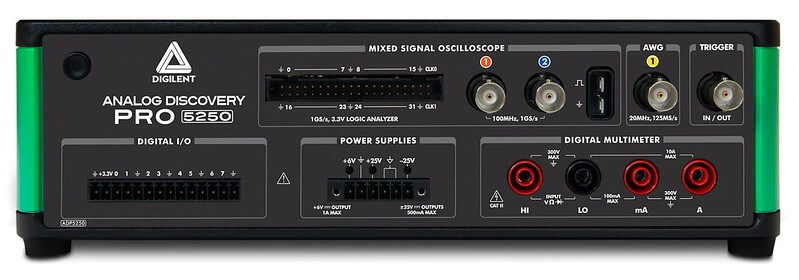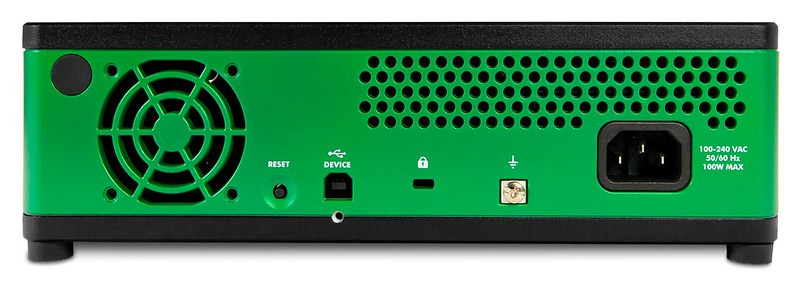A Mixed-Signal Oscilloscope, Function Generator, Power Supply, and Digital Multimeter in One Package
Earlier this year, we debuted the popular Analog Discovery Pro 3000 Series as a professional upgrade of the versatile, wallet-sized Analog Discovery 2. Now, we’re pushing the boundaries even further and introducing the next Analog Discovery Pro, the ADP5250, truly the biggest, baddest, and boldest Analog Discovery to date.


The ADP5250 brings higher bandwidth (100 MHz) and sample rate (1 GS/s single channel) to two analog input channels and a more rugged design to the Analog Discovery Pro Family. Still included for free is the configurable customer favorite WaveForms software, so users will still have easy access to the same test and measurement tools (The ADP5250 supports the Oscilloscope, Waveform Generator, Power Supplies, DMM, Logic Analyzer, Static I/O, and the Spectrum, Network, and Impedance Analyzers instruments in the WaveForms software). Out of the box, the ADP5250 features a power supply (up to 25V), and it’s our first instrument to have built-in digital multimeter capabilities. With WaveForms, DMM capability, and the power supply, the ADP5250 truly is an all-in-one testing system.
“We saw a solution for test engineers that other products haven’t successfully addressed yet,” said Kaitlyn Franz, our Test & Measurement Products Manager. “The ADP5250 takes multiple technologies and puts them into a single system that any test engineer can benefit from, giving them a reliable way to work on a majority of their needs.”
What Features Does the ADP5250 Include?
Analog Inputs:
- Used in the Oscilloscope, Network Analyzer, Spectrum Analyzer, and Impedance Analyzer
- Two analog input channels accessible via front panel BNC connectors
- Channel type: single ended
- Analog bandwidth: 100 MHz @ -3 dB
- 8-bit resolution
- Max sampling rate: 1 GS/s single channel
- Maximum input range: 40 V peak to peak
- AC or DC coupling
- Maximum record length: 1 MS per channel
Analog Outputs:
- Used in the Waveform Generator, Impedance Analyzer, and Network Analyzer
- One channel accessible via a front panel BNC connector
- 14-bit resolution
- AC amplitude (max): ±12 V
- Maximum analog bandwidth: 50 MHz @ 3 dB
- Maximum sampling rate: 125 MS/s
Power Supplies:
- Digital supply: 3.3 V, 20 mA
- DC power supplies:
- 0 to 6 V variable, 1 A max current
- 0 to 25 V variable, 500 mA max current (isolated)
- 0 to -25 V variable, 500 mA max current (isolated)
Digital Multimeter:
- Used in the DMM instrument
- Functions: DC voltage, AC voltage, DC current, AC current, resistance, diode, continuity
- Resolution: 5 1/2 digits
- Sample rate 5 S/s
- Input protection:
- Resistance, diode: up to 300 V DC
- DC and AC voltage: up to 300 V DC or 265 VAC (rms) 400 V AC (peak)
- DMM A current connector fuse: internal ceramic fuse, 10 A 250 V, time-delay, 5 x 20 mm, T 10 A H 250 V
- DMM mA current connector fuse: internal ceramic fuse, 1.25 A 250 V, time-delay, 5 x 20 mm, T 1.25 A H 250 V
- Maximum common-mode voltage: 300 V DC or AC (rms)
Digital Inputs:
- Used in the Logic Analyzer
- Channels: 34
- Input voltage: 0 V to 5 V
- Input threshold: 0 V to 2 V
- Max sampling rate: 1 GS/s
- Typical record length: 1 MS
Digital I/O:
- Used in the Static I/O instrument
- Channels: 8
- Input logic standard: 5 V compatible TTL
- Output logic standard: 3.3 V LVTTL
Advanced Triggering:
- Trigger sources: oscilloscope analog channels, function generator start, digital inputs, digital I/O, power line frequency, external trigger
- Trigger modes
- Normal, auto, force, single
- Analog trigger
- Edge with hysteresis
- Digital trigger
- Edge, level, pattern, glitch
- External trigger:
- 5 V compatible TTL input or 3.3 V LVTTL output
- 4 mA drive strength
Connectivity:
- Device to computer: USB 2.0 Hi-Speed
Miscellaneous:
- Auxiliary powered
- Dimensions: 25.40 cm x 19.05 cm x 7.77 cm (10.00 in x 7.50 in x 3.06 in)
- Weight: 2.05 kg (4 lb 8.3 oz)
- Shock and vibration tested (details in the specification sheet)


The ADP5250 store page indicates that this is Windows only? Do you plan to support Mac, and if so when will it be available?
100MHz bandwidth with 1GS/s sampling looks nice, but only 8-bit resolution not so nice. For low-speed work, the Analog Discovery 2 is still a better instrument.
Isn’t that just the old NI Virtual Bench? Except for the colors, it looks exactly the same.
I feel like I already have one of these. But mine is NI blue, and this one is green. Remarkable coincidence.
I use it every day.
Awesome that it’s found its way into your daily use! This is an adaptation of Virtual Bench for the large and rapidly growing Digilent Analog Discovery user base. It’s setup for the same Waveforms app software that supports our entry level Analog Discovery 2 (the de facto standard portable/pocket multi-instrument on university campuses around the world) and the ADP3250/3450 high-resolution MSO introduced earlier this year, giving customers a path from a low-cost pocket device to a rugged, high-performance device without having the learn a new user interface.
Basically, WaveForms is something that we feel should be available at all levels.
I think Mr Olson was ironic … the interface between virtual bench and this Digilent look exactly the same, but the original is blue
I have the original Analog Discovery, was fortunate to purchase with $100 employee discount (MSRP $199) while working at Analog Devices in 2013. It is still working & no plan upgrading to AD2. I’m using Analog Discovery as audio signal generator for vintage class AB amplifier. The 5MHz bandwidth is more than enough for frequency response measurement. Its scope serve as back-up to my bench-top scope.
The best thing about this product is the company. These people just keep innovating. It may be the education focus, it may be the culture. Hard to know from outside. I greatly appreciate the product development. Yes, there will always be trade offs when working within any given hardware portfolio. The key is: Digilent lets the user select how those trade offs work for their needs.